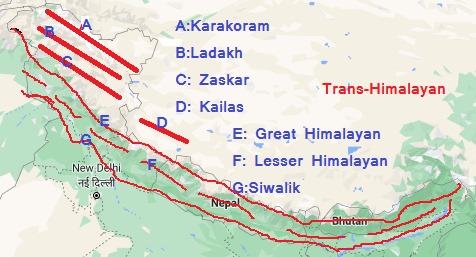Introduction:
The Himalayas, renowned as the youngest and structurally folded mountains on Earth, stand as a remarkable geographical and geological wonder. These towering peaks have left an indelible mark on the Indian subcontinent, influencing climate, ecology, and human civilization in profound ways. This discussion delves into the geophysical characteristics of the Himalayan region, shedding light on its unique attributes.
Main Body:

Important Geophysical Characteristics of the Himalayan Region:
Unique Geographical Features:
- The Himalayas are distinguished by their towering height, intricate geological composition, snow-clad peaks, extensive valley glaciers, deep river gorges, and lush vegetation.
- This region, characterized by ongoing tectonic activity, continues to evolve as a result of the collision between the Indian and Eurasian tectonic plates.
Divisions of the Himalayas:
The Himalayas are segmented into several parallel or converging ranges, each with distinct characteristics:
- Shiwaliks or Outer Himalayas: These foothills provide a transitional zone between the plains and the mountainous terrain.
- Lesser or Middle Himalayas: Known for their lush forests and rolling hills, they form an intermediate zone.
- Greater Himalayas: Home to some of the world’s highest peaks, including Mount Everest, these mountains exhibit rugged terrain.
- Trans-Himalayas (Tibetan Himalayas): Situated to the north, these arid highlands present a unique landscape.
- Eastern Hills (Purvanchal): These hills stretch across northeastern India, enriching the region’s biodiversity.
Topographic Complexity:
- The Himalayas are marked by deep valleys that separate these mountain ranges, creating a highly dissected topography.
- Southern slopes exhibit steep gradients, while the northern slopes have gentler inclines. For instance, scaling Mount Everest is less demanding from the southern Nepalese side due to this topographical variation.
Geographical Extent:
- The Himalayan mountain system extends across India, Nepal, and Bhutan, with parts of the northern slopes located in Tibet (Trans-Himalayas).
- Its western reaches stretch into Pakistan, Afghanistan, and Central Asia.
Hydrological Significance:
- The Himalayas are the source of 19 major rivers, with the Indus and Brahmaputra being the largest.
- These rivers play a vital role in supporting agriculture and livelihoods in the Indian subcontinent.
Meteorological Influence:
- Acting as a climatic divide, the Himalayas significantly impact meteorological conditions.
- They obstruct the intrusion of cold, dry air from the north into India during winter and influence the monsoonal winds, leading to heavy rainfall on the Indian side and arid conditions in Tibet.
Diverse Vegetation Zones:
- The Himalayan region boasts a rich tapestry of vegetation, categorized into tropical, subtropical, temperate, and alpine zones.
- The prevalence of each zone is primarily determined by factors such as elevation and precipitation.
Conclusion:
In conclusion, the youthful Himalayas, characterized by their extraordinary geophysical attributes, stand as a testament to the marvels of our natural world. As the first line of defense for the Indian subcontinent, these mountains have left an indelible mark on the landscape, climate, and culture of the region.
Studying and appreciating the geophysical characteristics of the Himalayan region is not only a scientific pursuit but also a celebration of the awe-inspiring beauty and significance of this unique mountain range.
